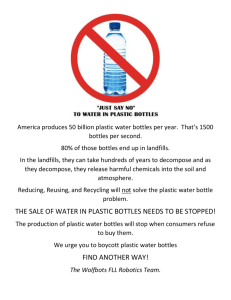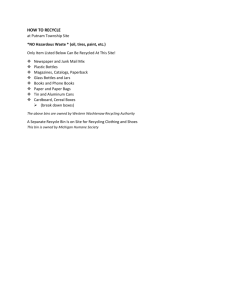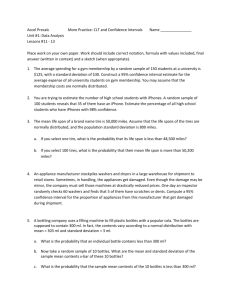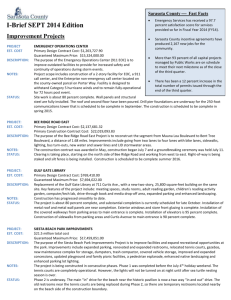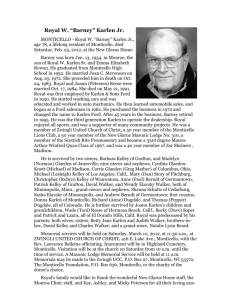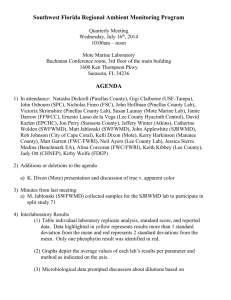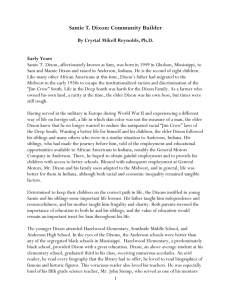July 18, 2013 RAMP Meeting Minutes
advertisement
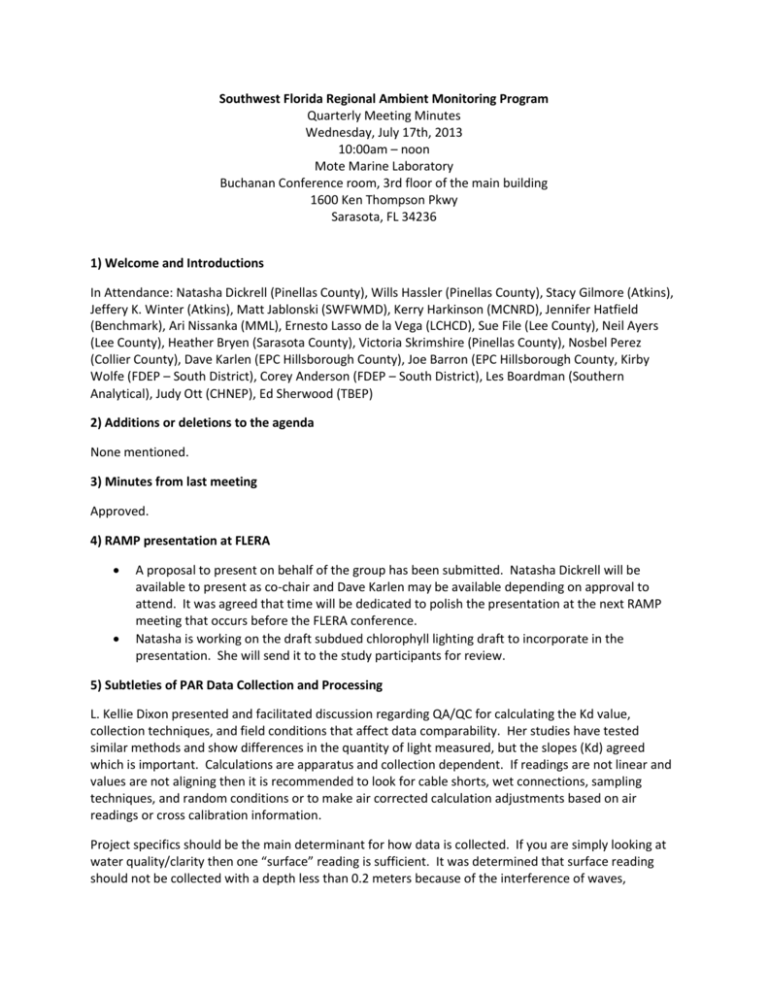
Southwest Florida Regional Ambient Monitoring Program Quarterly Meeting Minutes Wednesday, July 17th, 2013 10:00am – noon Mote Marine Laboratory Buchanan Conference room, 3rd floor of the main building 1600 Ken Thompson Pkwy Sarasota, FL 34236 1) Welcome and Introductions In Attendance: Natasha Dickrell (Pinellas County), Wills Hassler (Pinellas County), Stacy Gilmore (Atkins), Jeffery K. Winter (Atkins), Matt Jablonski (SWFWMD), Kerry Harkinson (MCNRD), Jennifer Hatfield (Benchmark), Ari Nissanka (MML), Ernesto Lasso de la Vega (LCHCD), Sue File (Lee County), Neil Ayers (Lee County), Heather Bryen (Sarasota County), Victoria Skrimshire (Pinellas County), Nosbel Perez (Collier County), Dave Karlen (EPC Hillsborough County), Joe Barron (EPC Hillsborough County, Kirby Wolfe (FDEP – South District), Corey Anderson (FDEP – South District), Les Boardman (Southern Analytical), Judy Ott (CHNEP), Ed Sherwood (TBEP) 2) Additions or deletions to the agenda None mentioned. 3) Minutes from last meeting Approved. 4) RAMP presentation at FLERA A proposal to present on behalf of the group has been submitted. Natasha Dickrell will be available to present as co-chair and Dave Karlen may be available depending on approval to attend. It was agreed that time will be dedicated to polish the presentation at the next RAMP meeting that occurs before the FLERA conference. Natasha is working on the draft subdued chlorophyll lighting draft to incorporate in the presentation. She will send it to the study participants for review. 5) Subtleties of PAR Data Collection and Processing L. Kellie Dixon presented and facilitated discussion regarding QA/QC for calculating the Kd value, collection techniques, and field conditions that affect data comparability. Her studies have tested similar methods and show differences in the quantity of light measured, but the slopes (Kd) agreed which is important. Calculations are apparatus and collection dependent. If readings are not linear and values are not aligning then it is recommended to look for cable shorts, wet connections, sampling techniques, and random conditions or to make air corrected calculation adjustments based on air readings or cross calibration information. Project specifics should be the main determinant for how data is collected. If you are simply looking at water quality/clarity then one “surface” reading is sufficient. It was determined that surface reading should not be collected with a depth less than 0.2 meters because of the interference of waves, refraction, reflection, etc at the surface. If you are looking at decay of light or available light for seagrass monitoring then data should be collected throughout the water column. Collection techniques discussed were evaluating skylight, determining reflection from vessels and orientation since these conditions can affect the light the sensors capture differently. Overcast conditions or clear sky conditions should not be a factor in collecting light – the consistency of the light is what is important for kd determination. Partly cloudy days can affect results, but attention to cloud cover during collection can diminish these effects. Integration times should be set at 5 seconds for internal averaging and as the interval between collections. It was suggested that 8 seconds be used for collection to allow for the sensors to acclimate. Could the Kd of the upper sensor and the Kd of the bottom sensor be averaged versus looking at the 4 point linear regression? (My notes aren’t clear on the determination for this question – please offer comments if you are able!) Would continuous lighting studies be valuable? It does provide information on the optimal time for collection based on the sun angle, but it is already determined that the best time range to collect is between 10am – 2pm. The discussion about reporting true color and apparent color was presented. In relation to the optical model, true color is desirable, but the use in water quality shows comparable interpretation. If you have a vast history of apparent color data then continue, but if you are looking to use this particular model then reporting true color would be a recommended addition. It was stated that the beauty of this model is that it can show a direct link between water quality and the biological indication (e.g. seagrass health/abundance). The model can provide information about past and predicted values when the necessary components are available (e.g. most programs have been collecting chlorophyll and turbidity and kd, but not color. This could provide historical color information based on current information.) Kelli Dixon offered to look at the comparison results from the study today and offer her feedback. Dave Karlen will assemble and provide that information to her. 6) Interlaboratory Results Comparisons were favorable. One laboratory commented on their ongoing improvements with chlorophyll analysis. An inquiry about the use of HPLC was brought up and many laboratories responded that this equipment was expensive and not widely used, and if used it is used for oceanographic studies. It was indicated that results can be impressive based on the ability to identify a range of pigments and the application to phytoplankton community analysis. When algorithms and composition are programmed it can be quite accurate and time saving compared to performing phytoplankton counts and identification and can determine composition of specific phytoplankton like diatoms versus dinoflagellates. There has been use of HPLC to determine karenia brevis presence. 7) New Business Kelli Dixon offered hosting a webpage on the Coastal Ocean Study FWC website under the “Other Research” page. This page is usually used for HAB cataloging. Ed Sherwood mentioned that the FWQMC would be developing a catalog of coastal monitoring similar to a widely known Water Atlas. Natasha Dickrell asked if anyone else was familiar with the Florida Benchmark consortium since they requested and collect similar data. No participants were familiar. We decided to discuss the opportunities of having information on society, research, agency pages at an upcoming meeting. A coastal monitoring standard operating procedure is being produced and the question of whether bottle rinsing was standard among participant’s programs. Rinsing was most dependent on internal procedures when bottles are recycled and washed in house or if bottles are provided certified clean from a laboratory or vendor. Certified clean bottles or bottles supplied directly from the laboratories were not rinsed while recycled bottles were rinsed in the field. It was confirmed that field replicates are not mandatory but some programs continued to find value from duplicates, either by providing additional QA or highlighting areas of improvement with sample collection in general. 8) Next Meeting: Wednesday, October 9th 10:00am (decided to meet during the second week to avoid conflict with Symposium in Sarasota). Heather Bryen will look into reserving the Colonial Oaks location. Field probe comparison will be scheduled for the January meeting to allow time to go over the FLERA presentation at the next meeting. 9) Sample Exchange with PAR measurements Saline water sample from Sarasota Bay with nutrient spikes added. Two readings will be taken for PAR: one independent and one where all participants are concurrently collecting readings. Raw data and kd values can be submitted to Dave Karlen and he volunteered to organize and send to Kellie Dixon.


